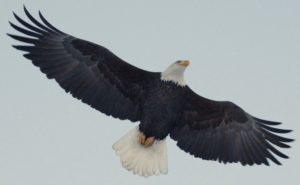By Saundra McBrearty, Outreach and Volunteer Services Specialist

photo from Wikipedia Commons
I spotted an enormous black bird soaring gracefully overhead while I was traveling north to visit family for the holidays. The striking appearance of this commanding bird – with with a six-foot wing span, wide wing width, and finger-like wing tips – helped me identify it as a bald eagle even before I caught a glimpse of its yellow feet and glowing white head and tail.
Bald eagles inspire us; in fact this commanding bird is our national symbol. Humans, however, have impacted the populations of these impressive birds with our actions and subsequent laws to protect them. In the latter half of the 20th century, the bald eagle was classified as an endangered species. Its population plummeted due to widespread pesticide use, which accumulated in animals throughout the food chain. Through the diligent efforts of wildlife biologists and a concerned public, the bald eagle population has recovered and the bird is no longer on the federal or state endangered species list.
Eagles have continued to recover from a frighteningly low number of only four breeding pairs in 1979. From 2012 through 2016, the estimated average number of nests each year was 203, and the estimated average number of young was 294. Specifically in 2016, the number of estimated breeding pairs flattened out at 207, and pairs produced an estimated 327 young. The lack of growth in number of breeding pairs may indicate a stabilization of the population.
While breeding populations tend to be more concentrated in certain areas, bald eagles can be seen wintering throughout Ohio and can now be found around marshes, swamps, and river systems around the state. We have a number of nests in Delaware County and, if you look towards the sky, you might just see a beautiful bald eagle soaring above.
FACT: Juvenile bald eagles take five years to grow the white head and tail feathers.
Juveniles are a mottled dark brown, and probably are often misidentified. Size is their give -away.
To learn more about bald eagles, click here to visit the Cornell Lab of Ornithology’s All About Birds web site.






